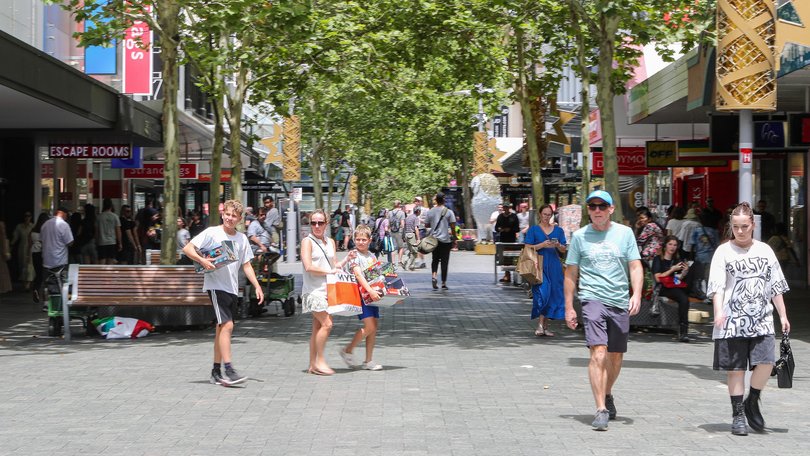Australian consumer stress levels fall amid slowing inflation, NAB says, as household spending ticks up

The number of Australian consumers reporting “very high” stress has fallen to a three-and-a-half-year low amid slowing inflation and increasing confidence of further interest rate cuts in the next year.
While the cost-of-living crunch still weighed heavily on consumers, their stress levels eased to the lowest since March 2022 as headline inflation held steady within the Reserve Bank of Australia’s 2-3 per cent range. It is widely expected to stay low in the near future.
National Australian Bank on Friday revealed the number of consumers reporting “very high” stress fell to a three-and-a-half-year low in the June quarter.
Sign up to The Nightly's newsletters.
Get the first look at the digital newspaper, curated daily stories and breaking headlines delivered to your inbox.
By continuing you agree to our Terms and Privacy Policy.The findings from NAB came the same day the Australian Bureau of Statistics revealed household spending ticked up 0.9 per cent to over $76 billion in May.
The result was much stronger than the 0.2 per cent lift in May’s retail trade and beat market expectations for a 0.5 per cent lift.
Economists say the splurge was likely fuelled by end of financial year sales and positive consumer sentiment following the RBA’s second rate cut in May.
Commonwealth Bank senior economist Belinda Allen said there was a strong bounce in clothing and footwear spending in the month.
“Transport spending was stronger on new car purchases and so too was eating and drinking out,” she said.
According to the ABS, Australians spent a total of $9.7b on hotels, cafes and restaurants in May, up nearly $73m on the prior month.
The clothing and footwear category recorded the biggest growth, with spending up 3.7 per cent to $4.3b. This was after a 3.5 per cent fall in April.
As a result, discretionary spending rose 1.1 per cent to outperform the non-discretionary category, up just 0.5 per cent.
“Signs of green shoots around discretionary spending are positive, but there remains a preference to save and pay down debt,” Ms Allen said.
“A sluggish consumer reinforces the fragile nature of the expected consumer recovery and raises downside risks for the Australian growth outlook.
“We continue to expect an improvement in discretionary spending this year, but scarring from the loss of real household disposable income between 2022 to 2024 means the timing and extent of a rebound is uncertain.”
Across the country, WA and Queensland posted the second-biggest growth, both up one per cent to $8.9b and $15.9b, respectively. They closely followed the Northern Territory, up 1.2 per cent to $819.3m.
ANZ’s Aaron Luk and Adam Boyton said overall, it was too soon to suggest the economy had reached a turning point and consumer demand was recovering solidly.
This week, ANZ joined the queue predicting an interest rate cut next week following weak retail sales.
That brought ANZ into line with the other big four banks anticipating the RBA to cut the cash rate from 3.85 per cent to 3.6 per cent on July 8.
But Ms Allen on Friday warned the 0.25 basis-point reduction in the cash rate was “not a done deal”.
“The RBA will consider leaving the cash rate on hold. The cutting cycle to date has so far been paced at once a quarter,” she said.
“This allowed the board to have full oversight of the most recent quarterly consumer price index print.
“Diminished trade uncertainty since the heightened May environment and a still tight labour market are likely arguments that will be used to discuss the case to leave the cash rate on hold.”
According to NAB, most consumers continued to respond to cost-of-living pressures by cutting their spending on eating out at restaurants, as well as treats like takeaway coffees, entertainment, travel and holiday plans, car journeys to save petrol, and food delivery services.
They are also scaling back on major household purchases, charitable giving and paid streaming services, like Netflix.
The bank also asked consumers how the cost of living crisis had impacted their spending on health.
Of concern, three in 10 cancelled or cut back spending on health practitioner visits, such as doctors and dentists.
Consumers remained least inclined to cut spending on private school fees and tutors, their children’s activities, such as sports and hobbies, as well as on their pets.
Nearly 60 per cent used the extra cash made from cutting back for daily living expenses, while over four in 10 put it into savings or offset accounts. A slightly lower number of Australians paid down their mortgage.
Consumers who cancelled, delayed or cut spending were also asked to estimate how much they saved a month by doing so.
In the June quarter, they saved nearly $530 by cancelling or delaying holiday plans, $447 by holding off on major household purchases, and $130 from scaling back visits to health practitioners.
Most consumers were also still reporting higher prices for groceries and utilities.
When asked how they see the year ahead, a much higher number of Australians now expect interest rates to decrease in the next 12 months.
“With the potential for more cuts on the horizon, the share of Australians who expect house prices to increase over the next 12 months also grew sharply,” NAB said.
Across the country, Tasmania replaced Victoria as the most stressed State. WA was the third most stressed State.

